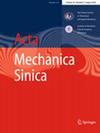Mechanical-guided assembly of three-dimensional (3D) mesostructures from pre-defined 2D precursors based on the deterministically controlled buckling has attracted increasing attention in both fundamental and applied research areas, owing to the compelling advantages in developing flexible electronic devices with complex 3D geometries and novel functions. Recently, a buckling-guided strategy was reported to enable assembly of complex 3D mesostructures and electronic devices on cylindrical and cylinder-like substrates, which can be integrated with vascular systems for monitoring of flow rate and other physical signals. A clear understanding of nonlinear buckling deformations of elastic beams assembled on cylindrical substrates is thereby essential for the relevant structural design. In this work, we present a systematic study on the nonlinear deformations of buckled ribbon-type structures on cylindrical substrates. Two representative classes of ribbon-type structures are considered, including arc structures and serpentine structures. Starting with the finite-deformation beam theory, a theoretical model is established to investigate deformed configurations resulted from the controlled buckling, including ribbons assembled on both outer and inner surfaces of the substrate. The structure-substrate contact and self-contact are taken into account in the analyses, which could lead to distinct deformed configurations. Both experimental studies and finite element analyses (FEA) were carried out to validate the developed theoretical model. A demonstrative device design based on the 3D ribbon network outside the cylindrical substrate suggests potential applications in energy harvesting across a broad range of frequency. The theoretical model presented herein could offer insights for the practical design of 3D electronic devices that can be conformally integrated with curvy biological surfaces.


